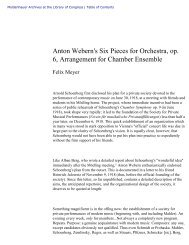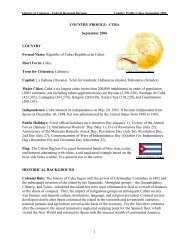1 - American Memory
1 - American Memory
1 - American Memory
Create successful ePaper yourself
Turn your PDF publications into a flip-book with our unique Google optimized e-Paper software.
210<br />
To illustrate the extent of this impact, I submit for the record a<br />
copy of a study conducted in early September 1974, by the Bank of<br />
Hawaii Business Research Department [see p. 214]. An examination<br />
of the repli^ submitted bjr a variety of businesses dealing in consumer<br />
and industrial commodities revealed that the average inventory car-<br />
ried year-romid was 103 days. Asked what inventory they would<br />
carry if assured that a west coast shipping interruption would last<br />
no longer than 10 days, the average of the replies of the respondents<br />
to this question was 68 days—or a saving of 35 days because of such<br />
an assurance.<br />
Further, 70 percent of the respondents said they are affected year-<br />
round because of a lack of such assurance; 19 percent said they take<br />
the risk of building inventory only when the possibility of a shipping<br />
interruption looms; and only 11 percent said they are not affected by<br />
shipping interruption threats.<br />
The 70 percent who said they are affected on a year-round basis<br />
reported that their average inventory valuation was over $2,615,000<br />
and that a guarantee that shipping from the west, coast would not be<br />
interrupted for more than 10 days would enable them to reduce inven-<br />
tory valuation to an average of about $1.8 million^—or a reduction of<br />
31 percent.<br />
Considering the high warehousing and financing costs in Hawaii, a<br />
31-percent reduction in valuation and a 34-percent reduction in inven-<br />
tory days, if extended across the entire commodity spectrum, would<br />
mean a savings of tens, if not hundreds of millions of dollars annually<br />
to Hawaii's consumers.<br />
Permit me to cite another study, one made by the C. W. Shafer Dis-<br />
tributing Co., an appliance and television wholesaler in Honolulu,<br />
with a copy of the complete material presented on September 14,1974,<br />
submitted for the record.<br />
The 40 cents per square foot per month for warehouse space in<br />
Honolulu compares with 6 cents per square foot per month in San<br />
Diego. Warehouse space can be found in Honolulu at less than 40 cents<br />
per square foot, but anything below 30 cents is virtually impossible to<br />
find. The Shafer survey indicates that the same kind of operation in<br />
San Diego has an inventory investment of $100,000 as compared to<br />
an inventory investment of $300,000 in Honolulu. The survey also<br />
states that an appliance distributor's expenses in Honolulu average<br />
15 percent more than for distributors on the mainland. An example<br />
cited is a color television set selling for $500 on the mainland which<br />
has to be priced at $575 in Honolulu.<br />
Mr. Shafer reported to me that the passage of H.R. 7189 would<br />
enable his company to reduce its standard 90-day inventorv to 60 days<br />
and his inventory investment from $300,000 to about $200,000. Further,<br />
his interest expense would drop from $39,000 to $26,000 or less and<br />
warehousing costs could decline from $4,800 per month to $3,200 per<br />
month. The savings on warehousing and interest costs alone would<br />
reduce his cost of doing business in the range of $32,000 to $35,000 per<br />
year—or almost 3 percent of his annual sales figure of $1.2 million.<br />
I conducted a poll of five major printers in Honolulu (August 1974)<br />
and learned that their average paper inventory is 5 months. I assure<br />
this committee that no printers on the mainland would consider ware-



![Albert Einstein Papers [finding aid]. Library of Congress. [PDF ...](https://img.yumpu.com/21604228/1/190x245/albert-einstein-papers-finding-aid-library-of-congress-pdf-.jpg?quality=85)





![American Colony in Jerusalem Collection [finding aid]. Library of ...](https://img.yumpu.com/17941275/1/190x245/american-colony-in-jerusalem-collection-finding-aid-library-of-.jpg?quality=85)



![Piccard Family Papers [finding aid]. - American Memory - Library of ...](https://img.yumpu.com/17941234/1/190x245/piccard-family-papers-finding-aid-american-memory-library-of-.jpg?quality=85)


